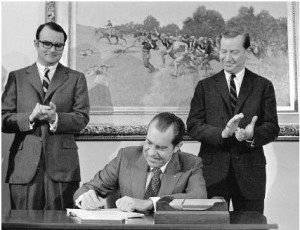Congress is famous for passing laws so large and cumbersome that they are hard to interpret. Remember Nancy Pelosi’s infamous line, “We have to pass the bill so you can find out what’s in it.” That was said of a 2,000-page bill.
The Declaration of Independence was one page and the Constitution only six. The law adding Colorado to the union was five pages, though quite detailed in its requirements. The 1862 Homestead Act, which offered western settlers 160 acres of land, granted more than 1.6 million homesteads and successfully privatized 270 million acres in the West, was only two pages. The law granting the right to build roads across public lands, essential to the settlement of Western Colorado, was only one sentence.
I’m not sure why our laws became so complicated that they now require hundreds of pages, but it happened gradually. The 1935 law creating Social Security, unemployment compensation, child welfare services, aid to the blind, and the related payroll taxes, filled all of 29 pages. Even the landmark Civil Rights Act of 1964 took only ten pages to enforce voting rights and ban discrimination in public accommodations, facilities, and education.
By the time Congress passed the Clean Water Act in 1972, it required 132 pages – comparatively lengthy but still readable and with fairly clear language. That is, except to the EPA.Followers of the debate over the proposed new “Waters of the United States” (WOTUS) rule were fascinated by the EPA’s handling of a small ranch owner in Wyoming named Andy Johnson. His ranch supports a small herd of cattle and several horses, and he improved it by building a small stock pond, as is common on ranches everywhere. The pond required only a small sand and gravel dyke across a little stream that runs through the ranch, and Johnson obtained the required State permits.
As is also common in the West, the little stream runs intermittently and turns muddy after it rains, but the pond helps filter the water, so besides watering livestock it also improves water quality downstream, as well as providing habitat and wetlands for fish and wildlife. No good deed goes unpunished, so along came the EPA – the same EPA whose own activities poisoned hundreds of miles of the Animas and San Juan Rivers with over 3 million gallons of toxic sludge. That same EPA accused Andy Johnson of discharging dredge and fill material into the little stream, called Six Mile Creek, which flows into Blacks Fork, which then flows into the Green River, which the EPA says is a “navigable, interstate waterway of the U.S.”
Notice that EPA did not claim Six Mile Creek, or even Blacks Fork, are “navigable waterways.” That’s important because the Clean Water Act gives EPA authority to regulate “navigable interstate waterways.” So EPA has now proposed the new WOTUS rule to define what constitutes “navigable.” Hint: the new rules define it as almost every drop of water in the country. Almost.
There are several exceptions Congress explicitly wrote into the Clean Water Act, including stock ponds on ranches. Even in complex legislation, that exemption is plain as the ink on the page. The EPA’s own website lists “Activities Exempt under the Clean Water Act,” which include “Construction and maintenance of farm or stock ponds.” The website explains that “You do not generally need a permit… if your discharges of dredged or fill material are… associated with normal farming, ranching, or silviculture activities.”
Johnson’s pond is clearly not navigable or interstate. So why did EPA assert its authority over the pond, and threaten the rancher with $20 million in fines? The language of the Clean Water Act is crystal clear, especially the one-line part that explicitly exempts stock ponds.
In the explanation of its proposed WOTUS regulations, the EPA inserted the key word, “dry,” which is not in the actual law. Referring to stock ponds, the explanation says “The proposed rule will not “affect areas generally previously excluded from jurisdiction, including… artificial lakes or ponds created by excavating and/or diking dry land and used for such purposes as rice growing, stock watering or irrigation.” [emphasis added]
Apparently, if Johnson had built his sand and gravel dyke across dry land where there was no water, EPA would have recognized his right to do so under the law. That would work fine, except that cattle do not generally drink dry land. No wonder EPA lost its court case against Johnson. Maybe in at least one case, the law actually means what it says.
A version of this column originally appeared in the Grand Junction Daily Sentinel July 15, 2016.





Comments on this entry are closed.